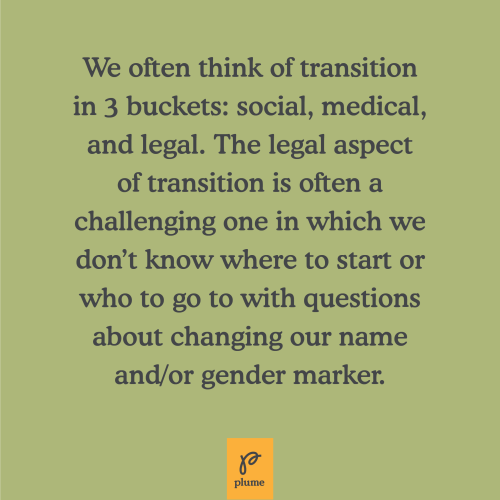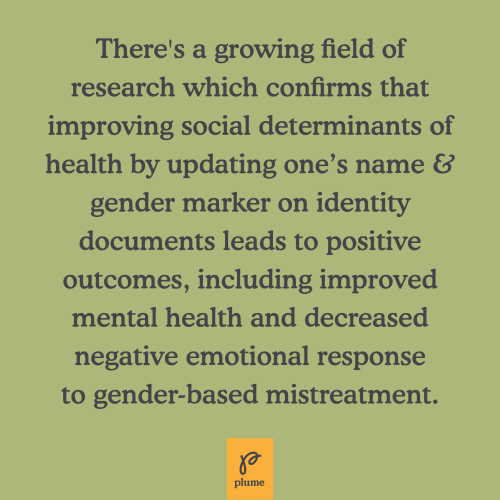#gender marker
QAC 77 - Legal Name Change || Non-Binary Gender Markers || “"Deadnames”“ || NEVADA
having socially ‘transitioned’ my name years ago, it feels amazing to finally have my name reflected correctly on legal documents, identification, etc. not only that, "X” as a gender marker has recently become a possibility for me…!
except, you know. not really. because everything always has to be complicated for me. always. and America is fucking ridiculous.
in this video, i talk about my personal experience with socially changing my name, the process & timeline of legally changing my name in Nevada / Washingon state, and go on a tangentially relevant rant about why i personally detest the term “deadname”.
for those interested in looking into legally changing your name and/or gender marker, check out these amazing resources:
https://transgenderlawcenter.org/
https://transequality.org/documents
legal ‘transition’ as a non-binary person in America is a joke, but i managed to not be overly bitter about it in the video somehow. just know that there was and is much internal screaming regardless. :’)
Lee says:
If you haven’t heard the news already, soon you’ll be able to self-select the gender marker you would like printed on your U.S. passport!
Here are the two key changes:
- The government no longer require medical documentation to change the gender marker on your U.S. passport!
- The government now allows you to choose “X” as a gender marker on your U.S. passport!
What does it mean to self-certify or self-select your gender marker on your passport?
Basically, now you don’t need to provide any documentation (medical or other) to change your gender marker on your passport.
So even if the gender you select on the application for a new passport doesn’t match the gender on your previous passport or other documents, you don’t need to supply any evidence or proof that you have been diagnosed with gender dysphoria or have medically, socially, or legally transitioned, or anything else.
This removes a big hurdle for trans people who want to update our IDs; there used to be a lot of hoops to jump through because people used to need a doctor’s note which not everyone had access to.
Now, you no longer need to provide medical certification or a physician’s letter if the gender marker you select for your U.S. passport does not match the gender on your citizenship evidence or photo ID.
Instead, you simply self-select the gender you would like them to print on your U.S. passport, by selecting “male (M)”, “female (F)”, or
“unspecified or another gender identity (X)”.
Does this mean all of your legal gender markers have to match?
Beyond removing the unnecessary and burdensome gatekeeping, these changes actually open up new options for transgender people.
Because your citizenship evidence or identification document does not need to match the gender you are requesting, you can actually have multiple legal gender markers.
That means your passport can say “X” even if you aren’t able to legally change your gender marker to X on your state ID or driver’s license because that isn’t an option in the state you live in yet.
Similarly, your passport can still say “X” even you aren’t able to update your birth certificate with an “X” because that isn’t an option in the state you were born in.
Because the gender you select for your passport does not need to match the gender on your supporting documentation, you’ll still be able to have your passport use your preferred gender marker regardless of the gender marker on your other forms of ID.
That means you can have a driver’s license that says “M” and a passport that says “F,” for example; the mix-and-match gender marker option isn’t restricted only to people who want an “X”.
Some people might like to have that flexibility earlier in their transitions when they aren’t consistently passing and want to have more than one option for their gender marker on legal identification.
For example, a non-passing trans man wants his driver’s license to show “M” because he identifies as male. While he knows that having “M” on his license would out him as being transgender because he isn’t passing yet, he doesn’t mind that because he feels safe in the state he lives in and the places he goes to and wants his ID to reflect his male gender identity. But when he travels overseas to a less-accepting area, but he wants to keep the “F” on his passport so he can have the option of going into the closet for his own safety in transphobic/homophobic places.
In other cases, some genderfluid or bigender people, for example, might like the validation that comes with having disparate binary gender markers on different forms of ID instead of having an X.
But the legal/logistical consequences of having mixed gender markers on different documents may turn out to be inconvenient at some point because of the difficulty in reconciling the various markers. So I personally would recommend keeping your gender markers congruent for now, and either update them all or leave them all the same. But it’s up to you of course!
I currently have “X” on my birth certificate and “F” on my driver’s license because I couldn’t update my license to “X” where I live since it wasn’t an option yet, so I do have mixed legal gender markers and it hasn’t been an issue yet.
What’s the deal with the photo needed for the passport?
While you don’t need to have the gender on your birth certificate and/or driver’s license changed before you can get the gender marker changed on my passport, the photo you submit with your passport application must look similar to the photo on your ID.
This means that you can’t be fully female-presenting on one ID and fully male-presenting in the photo of your other ID to the point where the two photos of you look like you’re siblings and not the same person.
So you’ll have to choose a single “look” that’s similar on both documents, whether you chose to try and aim for a more neutral/androgynous look or go fully masculine or fully feminine for both.
You will need to submit a new photo when applying for a passport, and the photo must look similar to your current appearance, must look similar to the photo on your ID, and must meet the passport photo requirements.
So, can I just go out and get a new passport card with an X right now?
Not yet. There’s a difference between a passport book and a passport card.
So before folks get too excited about the possibility of getting an X all their passport-related documents, I’d keep in mind that it actually isn’t an option on all passport-related documents yet because the government says that they won’t have their systems fully updated until sometime late next year. Oof.
Starting on April 11, 2022, you can select male (M), female (F), or unspecified or another gender identity (X) as your gender marker if you are applying for a U.S. passport book and selecting routineservice.
But it isn’t until late 2023 that the government anticipates completing additional technological updates so that the X gender marker will be available on the following documents they issue:
- Passportcards
- Emergency passports printed at embassies and consulates
- Expedited and emergency passports issued at passport agencies and centers
- Consular Reports of Birth Abroad (CRBAs)
So before late 2023, if a person visits the public counter of a passport agency needing a passport for immediate travel, like if they suddenly need to go overseas for a family funeral for example, they will have to select a binary gender marker (M or F).
Similarly, U.S. embassies and consulates will not be able to offer emergency passports with X gender markers until all technological updates are complete in late 2023.
If someone who has an X gender marker on their passport then loses their passport while traveling overseas, they will need to select a binary gender marker (M or F) to be issued an emergency passport for the return home.
But once they have completed their travel, they have up to one year from the date of issuance to apply for a free replacement routine passport with an X gender marker using Form DS-5504.
Ok, cool, but how do you actually update the gender marker on your passport?
“Well, the government is in the process of updating their Form FillerandForm Eligibility Wizard tools to incorporate the X gender marker, so you can’t use the online website that you’d normally use.
This means you need to download the PDF version of your passport form instead, and complete it by hand (in black ink!) if you are requesting a passport with an X gender marker.
Then you need to follow the steps listed on their ”Apply in Person“ page.
Children under age 16 must always apply using Form DS-11 and appear in person with both parents or legal guardians (if they have two legal parents/guardians).”
Well, what about people who currently have a limited-validity passport?
“Under the previous passport policies, if you were in the process of transitioning to a new gender when you applied for your passport, you may have received a limited-validity passport (issued for less than the full validity period of 10 years for those 16 and older and five years for children under 16).
But the government no longer requires medical documentation or a physician’s letter as evidence of a gender transition.
To replace a limited-validity passport with a full-validity passport in this situation, you’ll need to submit Form DS-5504.
To use this form, you must apply within two years of your previous passport’s issuance date. You do not have to pay fees unless you are requesting optional, expedited service.
If your limited-validity passport was issued more than two years ago, please use Form DS-11 and follow the steps on our Apply In Personpage.
Please note that expedited service is not yet available if you are applying for a passport book with an X gender marker.”
Anything else?
For folks who are looking to update their legal gender markers, whether it’s on your driver’s license, birth certificate, passport, social security record, or anything else, I’d highly recommend exploring the Trans Equality Document Center. It’s the resource that I used myself when I legally changed my name!
TRANS NEWS: Caroline Trottier-Gascon reports on the Proposed Regulations for Bill 35, which defines how a trans person can have their legal gender marker changed in Quebec. In December 2013, the surgical requirement for surgery has been removed, but we’ve been waiting for over a year to hear what regulations would replace the surgical requirement. In this audio clip Caroline explains the 3 proposed regulations and their short comings.
- 2 years lived experience in your gender presentation.
- Medical or Phycological testimony from a professional.
- A personal witness who has known you for at least 2 years.

Get Involved: As suggested in the clip, one way you can effect change is by writing to Minster Stéphanie Vallée directly. The public comment period is open till January 31st. Her mailing address is as follows:
L'Honorable Stéphanie Vallée
Ministre
Ministère de la Justice
1200, route de l’Église, 9e étage
Québec (Québec) G1V 4M1
Not sure what to write? Caroline has written a letter you can print, sign and mail. http://bit.ly/ToMinisterVallee
EVENTS: For more information, there will be info sessions in Montreal this Saturday January 17.
In english at the Centre for Gender Advocacy: Trans Rights - info session on the proposed regulation
In french at Centre St. Pierre: Séance d'information - Changement législatif et droits trans
Caroline Trottier-Gascon is a Quebecois writer, activist and amazing lady. Read more about Bill 35 and other relevant trans content on her blog.
This Episode of Trans News was originally aired January 8th, 2015 duringTranzister Radio #32.
Interested in getting your gender marker and name changed but don’t know where to start? We broke the process down to a step-by-step guide on our blog, including a timeline, a checklist for everything you need, and tips & tricks to navigating the legal system to successfully change your name and/or your gender marker!
Visit our full blog on Navigating Name and Gender Marker Changes at getplume.co/blog
Post link




